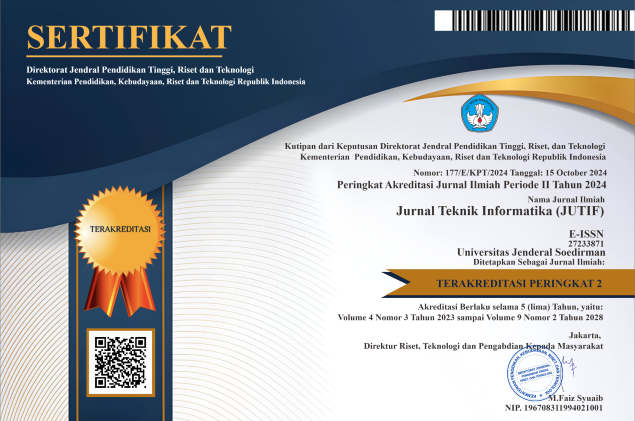Comparative Study of BiLSTM and GRU for Sentiment Analysis on Indonesian E-Commerce Product Reviews Using Deep Sequential Modeling
DOI:
https://doi.org/10.52436/1.jutif.2025.6.4.4878Keywords:
BiLSTM, Deep sequential representation, GRU, Indonesian product review, Sentiment AnalysisAbstract
Sentiment analysis plays a crucial role in understanding customer perspectives, especially within Indonesian e-commerce platforms. Despite the success of deep learning in high-resource languages, its application to Indonesian sentiment data remains underexplored. Previous studies using models like BERT-CNN or fine-tuned IndoBERT achieved modest results, highlighting the need for more effective architectures for Indonesian language. This study aims to investigate the effectiveness of Bidirectional Long Short-Term Memory (BiLSTM) and Gated Recurrent Unit (GRU) models in classifying buyers’ sentiment from Indonesian product reviews on the PREDECT-ID dataset comprising 5,400 annotated product reviews. Standard NLP preprocessing techniques—including text normalization, tokenization, stopword removal, and stemming—were applied. Both models were trained using Adam and Stochastic Gradient Descent (SGD) optimizers, and their performance was evaluated using accuracy, precision, recall, and F1-score metrics. The GRU model trained with SGD achieved the highest performance, with an accuracy of 94.07%, precision of 93.84%, recall of 94.53%, and F1-score of 94.18%. Notably, the BiLSTM model combined with SGD resulted in competitive results, achieving 93.61% accuracy and 93.84% F1-score. The results confirm that GRU with SGD optimizer, are highly effective for sentiment classification in Indonesian language datasets. By leveraging deep sequential modeling for a low-resource language, this study contributes to the advancement of scalable sentiment analysis systems in underrepresented linguistic domains. The results contribute to the advancement of NLP systems for Indonesian by providing a benchmark for the future development of sentiment analysis tools in low-resource languages.
Downloads
References
P. Campos, E. Pinto, and A. Torres, “Rating and perceived helpfulness in a bipartite network of online product reviews,” Electron. Commer. Res., vol. 25, no. 3, pp. 1607–1639, 2023, doi: 10.1007/s10660-023-09725-1.
H. Md Altab, M. Yinping, H. Md Sajjad, A. Nkrumah Kofi Frimpong, M. Frempomaa Frempong, and S. Sarfo Adu-Yeboah, “Understanding Online Consumer Textual Reviews and Rating: Review Length With Moderated Multiple Regression Analysis Approach,” SAGE Open, vol. 12, no. 2, 2022, doi: 10.1177/21582440221104806.
U. Singh, A. Saraswat, H. K. Azad, K. Abhishek, and S. Shitharth, “Towards improving e-commerce customer review analysis for sentiment detection,” Sci. Rep., vol. 12, no. 1, pp. 1–15, 2022, doi: 10.1038/s41598-022-26432-3.
K. Poonam and T. Ramakrishnudu, “Dual Bi-LSTM-GRU based stance detection in tweets ordered classes,” Neural Comput. Appl., vol. 37, no. 17, pp. 10439–10463, 2025, doi: 10.1007/s00521-024-10549-9.
J. Sangeetha and U. Kumaran, “A hybrid optimization algorithm using BiLSTM structure for sentiment analysis,” Meas. Sensors, vol. 25, p. 100619, 2023, doi: 10.1016/j.measen.2022.100619.
Z. Yu, Y. Sun, J. Zhang, Y. Zhang, and Z. Liu, “Gated recurrent unit neural network (GRU) based on quantile regression (QR) predicts reservoir parameters through well logging data,” Front. Earth Sci., vol. 11, pp. 1–8, 2023, doi: 10.3389/feart.2023.1087385.
A. R. Abas, I. Elhenawy, M. Zidan, and M. Othman, “Bert-cnn: A deep learning model for detecting emotions from text,” Comput. Mater. Contin., vol. 71, no. 2, pp. 2943–2961, 2022, doi: 10.32604/cmc.2022.021671.
R. Pramana, M. Jonathan, H. S. Yani, and R. Sutoyo, “A Comparison of BiLSTM, BERT, and Ensemble Method for Emotion Recognition on Indonesian Product Reviews,” Procedia Comput. Sci., vol. 245, no. C, pp. 399–408, 2024, doi: 10.1016/j.procs.2024.10.266.
Y. Aliyu, A. Sarlan, K. Usman Danyaro, A. S. B. A. Rahman, and M. Abdullahi, “Sentiment Analysis in Low-Resource Settings: A Comprehensive Review of Approaches, Languages, and Data Sources,” IEEE Access, vol. 12, pp. 66883–66909, 2024, doi: 10.1109/ACCESS.2024.3398635.
R. Sudheesh et al., “Bidirectional encoder representations from transformers and deep learning model for analyzing smartphone-related tweets,” PeerJ Comput. Sci., vol. 9, 2023, doi: 10.7717/peerj-cs.1432.
Z. Hameed and B. Garcia-Zapirain, “Sentiment Classification Using a Single-Layered BiLSTM Model,” IEEE Access, vol. 8, pp. 73992–74001, 2020, doi: 10.1109/ACCESS.2020.2988550.
M. K. Anam et al., “Improved performance of hybrid GRU-BiLSTM for detection emotion on Twitter dataset,” J. Appl. Data Sci., vol. 6, no. 1, pp. 354–365, 2025, https://doi.org/10.47738/jads.v6i1.459.
P. K. Jain, V. Saravanan, and R. Pamula, “A hybrid CNN-LSTM: A deep learning approach for consumer sentiment analysis using qualitative user-generated contents,” ACM Trans. Asian Low-Resour. Lang. Inf. Process., vol. 20, no. 5, pp. 1–15, 2021, https://doi.org/10.1145/3457206.
I. D. Mienye, T. G. Swart, and G. Obaido, “Recurrent Neural Networks: A Comprehensive Review of Architectures, Variants, and Applications,” Information, vol. 15, no. 9, p. 517, 2024, doi: 10.3390/info15090517.
R. Sutoyo, S. Achmad, A. Chowanda, E. W. Andangsari, and S. M. Isa, “PRDECT-ID: Indonesian product reviews dataset for emotions classification tasks,” Data Br., vol. 44, p. 108554, 2022, doi: 10.1016/j.dib.2022.108554.
K. K. Putri and E. B. Setiawan, “Depression Detection in Indonesian X Social Media Text using Convolutional Neural Networks and Long Short-Term Memory with TF- IDF and FastText Methods,” vol. 6, no. 2, pp. 557–574, 2025, doi: 10.52436/1.jutif.2025.6.2.4206.
I. P. A. Pratama, N. Wayan, and J. Kusama, “Comparative Analysis of Gradient-Based Optimizers in Feedforward Neural Networks for Titanic Survival Prediction,” vol. 6, no. 1, pp. 90–102, 2025, doi: 10.56705/ijodas.v6i1.219.
A. Mao, M. Mohri, and Y. Zhong, “Cross-Entropy Loss Functions: Theoretical Analysis and Applications,” Proc. Mach. Learn. Res., vol. 202, pp. 23803–23828, 2023, doi: 10.48550/arXiv.2304.07288.
S. Kiliçarslan and M. Celik, “RSigELU: A nonlinear activation function for deep neural networks,” Expert Syst. Appl., vol. 174, p. 114805, 2021, doi: https://doi.org/10.1016/j.eswa.2021.114805.
S. R. Dubey, S. K. Singh, and B. B. Chaudhuri, “Activation functions in deep learning: A comprehensive survey and benchmark,” Neurocomputing, vol. 503, pp. 92–108, 2022, doi: 10.1016/j.neucom.2022.06.111.
A. M. Iddrisu, S. Mensah, F. Boafo, G. R. Yeluripati, and P. Kudjo, “A sentiment analysis framework to classify instances of sarcastic sentiments within the aviation sector,” Int. J. Inf. Manag. Data Insights, vol. 3, no. 2, p. 100180, 2023, doi: 10.1016/j.jjimei.2023.100180.
N. Nurdin, K. Kluza, M. Fitria, K. Saddami, and R. S. Utami, “Analysis of Social Media Data Using Deep Learning and NLP Method for potential use as Natural Disaster Management in Indonesia,” in 2023 2nd International Conference on Computer System, Information Technology, and Electrical Engineering (COSITE), 2023, pp. 143–148. doi: 10.1109/COSITE60233.2023.10249849.
Richard, J. R. Andres, J. P. Soetandar, R. Sutoyo, and H. Riza, “Emotion Recognition Model using Product Review from Indonesia Marketplace,” in 2023 2nd International Conference on Computer System, Information Technology, and Electrical Engineering (COSITE), 2023, pp. 67–71. doi: 10.1109/COSITE60233.2023.10249811.
R. Obiedat et al., “Sentiment Analysis of Customers’ Reviews Using a Hybrid Evolutionary SVM-Based Approach in an Imbalanced Data Distribution,” IEEE Access, vol. 10, pp. 22260–22273, 2022, doi: 10.1109/ACCESS.2022.3149482.
E. O. Kiyak and B. Ghasemkhani, “High-Level K-Nearest Neighbors ( HLKNN ): A Supervised,” Electronics, vol. 12, pp. 1–20, 2023, doi: 10.3390/electronics12183828.
C. Dewi and R.-C. Chen, “Complement Naive Bayes Classifier for Sentiment Analysis of Internet Movie Database BT - Intelligent Information and Database Systems,” in Proc. Asian Conference on Intelligent Information and Database Systems, pp. 81–93, 2022, doi: 10.1007/978-3-031-21743-2_7.
B. Jlifi, C. Abidi, and C. Duvallet, “Beyond the use of a novel Ensemble based Random Forest-BERT Model (Ens-RF-BERT) for the Sentiment Analysis of the hashtag COVID19 tweets,” Soc. Netw. Anal. Min., vol. 14, no. 1, p. 88, 2024, doi: 10.1007/s13278-024-01240-x.
H. Liu, X. Chen, and X. Liu, “A Study of the Application of Weight Distributing Method Combining Sentiment Dictionary and TF-IDF for Text Sentiment Analysis,” IEEE Access, vol. 10, pp. 32280–32289, 2022, doi: 10.1109/ACCESS.2022.3160172.
M. S. Hossen, A. H. Jony, T. Tabassum, M. T. Islam, M. M. Rahman, and T. Khatun, “Hotel review analysis for the prediction of business using deep learning approach,” in Proc. 2021 Int. Conf. Artif. Intell. Smart Syst. (ICAIS), 2021, pp. 1489–1494, https://doi.org/10.1109/ICAIS50930.2021.9395757.
K. L. Tan, C. P. Lee, K. S. M. Anbananthen, and K. M. Lim, “RoBERTa-LSTM: A hybrid model for sentiment analysis with transformer and recurrent neural network,” IEEE Access, vol. 10, pp. 21517–21525, 2022, https://doi.org/10.1109/ACCESS.2022.3152828.
S. S. M. M. Rahman, K. B. M. B. Biplob, M. H. Rahman, K. Sarker, and T. Islam, “An investigation and evaluation of N-Gram, TF-IDF and ensemble methods in sentiment classification,” in Cyber Security and Computer Science: Proc. 2nd EAI Int. Conf. ICONCS, Dhaka, Bangladesh, 2020, pp. 391–402, 10.1007/978-3-030-52856-0_31.
Additional Files
Published
How to Cite
Issue
Section
License
Copyright (c) 2025 Khairunnisa Nasution, Khairun Saddami, Roslidar Roslidar, Akhyar Akhyar, Fathurrahman Fathurrahman, Niza Aulia

This work is licensed under a Creative Commons Attribution 4.0 International License.



























